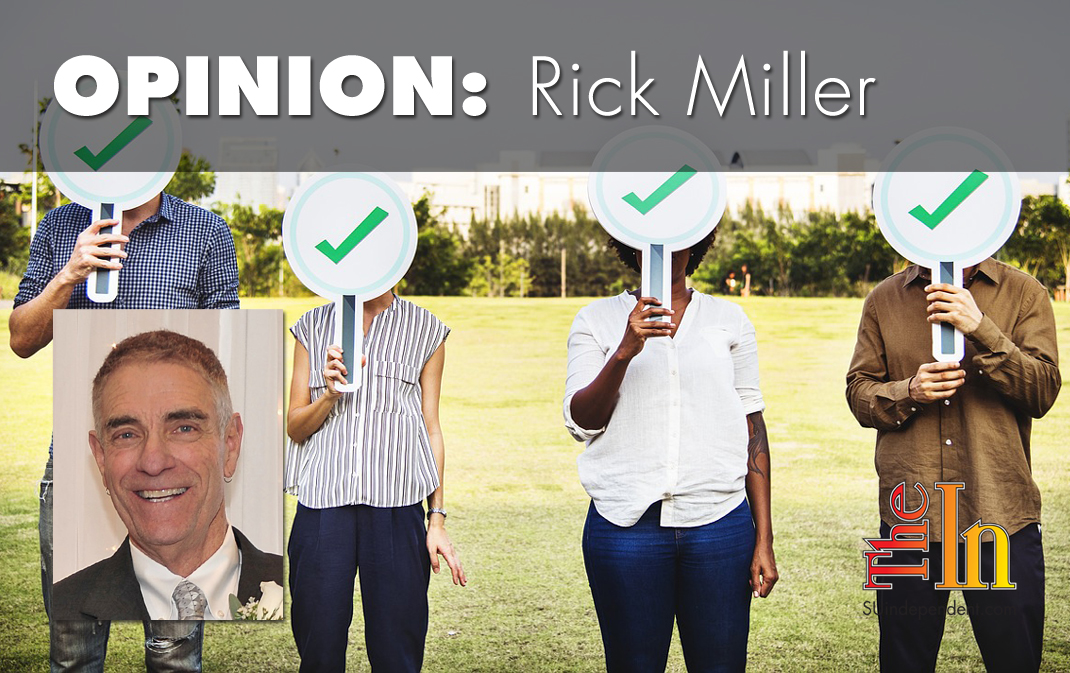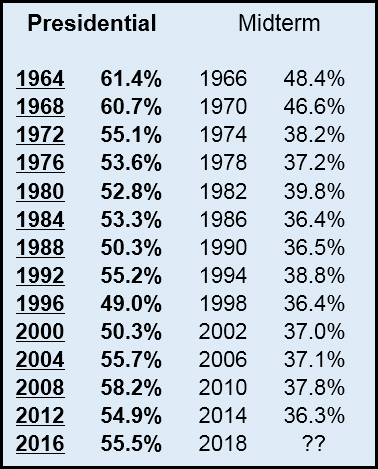 To vote or not to vote: So few seem to care about voting in elections
To vote or not to vote: So few seem to care about voting in elections
President Barack Obama gave a speech Sept. 9 in Anaheim California. To quote one of his remarks, “The biggest threat to our democracy is not one individual; rather, the problem is apathy and indifference.” He was referring to the low percentage of eligible American citizens who manage to vote in national elections. For example, the U.S. population in 2016 was approximately 320 million. Of that number, 250 million were eligible to vote. Of that number, just over 138 million managed to turn out and vote. So roughly only 55 percent of eligible voters were motivated enough to exercise their right to vote in the presidential election. This situation has existed for quite some time as indicated by the table below. Quite evident is that turnout percentage for presidential elections is low, but turnout percentage for midterm elections is truly abysmal.
 Apathy and indifference. Strong words to describe essentially “I just don’t care” as a reason for not voting. It’s also kind of ironic considering the current political, cultural, and economic situations in the U.S. For example, the Internet allows just about anyone to voice his opinion on just about any topic, and consequently the amount of vitriol and misinformation that inundates the Internet every day is mind boggling. Disparity among political, economic, and social beliefs has become a very divisive feature of our society. “Fake news” and “conspiracy theories” have become new buzzwords.
Apathy and indifference. Strong words to describe essentially “I just don’t care” as a reason for not voting. It’s also kind of ironic considering the current political, cultural, and economic situations in the U.S. For example, the Internet allows just about anyone to voice his opinion on just about any topic, and consequently the amount of vitriol and misinformation that inundates the Internet every day is mind boggling. Disparity among political, economic, and social beliefs has become a very divisive feature of our society. “Fake news” and “conspiracy theories” have become new buzzwords.
Although a vast amount of factual information is readily available in various types of current media, much discourse, especially from the “safety” of a computer, has brought forth all sorts of demeaning labels and ridicule. It is apparently difficult for many people to distinguish factual information from distorted information or even outright lies, especially if a writer has an agenda or hidden vested interest in spreading misinformation.
Ignoring the various candidates for national and local office, some topics and policies have become a focus for much of the current disparity: abortion, same-sex marriage, Medicare, taxes, public lands, welfare programs, entitlement, immigration, income disparity, public education vs. charter schools, higher education tuition, national debt, the environment, and guns. A person’s view of each of these is strongly related to his overall mindset, whether it is libertarian, conservative, or liberal. Of note is that all of these were present back in 1960 and were significant even then. However, methods and speeds of communication and discussion about these and other topics have changed dramatically.
Significant differences exist between 1960 and the present time. For example, back then the main methods of communicating news and information were newspapers, radio, and television, and there was some lag time between when events occurred and when they became public knowledge. That lag time and methods of disseminating information allowed for at least some editing and fact-checking sources. Currently, the main methods of communication are computers and cell phones, and events or information almost instantaneously become public knowledge. There is very little time for editing or fact checking sources.
According to the U.S. Census Bureau, the population of the United States in 1960 was approximately 180 million whereas the population had increased to approximately 325 million by 2017. That increase alone has had a significant impact on almost all of the topics listed above. For example, today public lands such as national parks, national forests monuments, and Bureau of Land Management lands are all affected by much more pressure from the public and from industry. Should they remain protected under federal control or transferred to states? Should they be decreased in size? Should they be developed or exploited for natural resources? Etc.
Another example is higher education. In 1960, when I was an undergraduate student at a California university, the state legislature proposed no tuition for in-state resident students. Now tuition at California state colleges and universities is thousands of dollars per quarter or semester. Although the student population has greatly increased, state government monetary support has greatly decreased in every state. This decrease in funding has resulted in many students graduating with significant loan debt, and a large percentage of current faculty are only part-time (adjunct) employees with low pay and no benefits. In the long run, is this situation beneficial to our society, or is it stifling and leading to a less educated population?
In 1960, abortion was illegal, same-sex marriage was not allowed, segregation was very prevalent in many areas of the country, there was no such thing as the Environmental Protection Agency, Medicare did not exist, charter schools were unheard of, and legal and illegal immigration was virtually ignored. All current changes in these ideas have come about through governmental actions, which basically means that they were and are all directly or indirectly determined by voters at elections and with greatly varying degrees of controversy. For many of these changes, the controversy still exists.
Over the years, many national elections, which determine who gets elected and therefore which programs are passed and which are not, are decided by only hundreds or a few thousands of votes out of millions of voters. So the rather lame excuse, “Well, my vote won’t make a difference, anyway” is quite lame considering there are today almost 100 million people who did not vote. Do you think that collectively those non-voters might have changed any local or even national election results by casting their ballots?
Well, on the other hand, voting is such a hassle. Why bother? You have to fill out a form to register, maybe take time off from work, and then have to drive to some inconvenient polling place, wait in line, and then think about making decisions on all that stuff on your ballot. It’s much easier and oh so much more fun to just sit at home, maybe have a beer or two, and spew out gripes and complaints on your computer or smartphone about some government official or some federal or state program that you like or don’t like but didn’t bother to vote for or against.
The viewpoints expressed above are those of the author and do not necessarily reflect those of The Independent.
How to submit an article, guest opinion piece, or letter to the editor to The Independent
Do you have something to say? Want your voice to be heard by thousands of readers? Send The Independent your letter to the editor or guest opinion piece. All submissions will be considered for publication by our editorial staff. If your letter or editorial is accepted, it will run on suindependent.com, and we’ll promote it through all of our social media channels. We may even decide to include it in our monthly print edition. Just follow our simple submission guidelines and make your voice heard:
—Submissions should be between 300 and 1,500 words.
—Submissions must be sent to editor@infowest.com as a .doc, .docx, .txt, or .rtf file.
—The subject line of the email containing your submission should read “Letter to the editor.”
—Attach your name to both the email and the document file (we don’t run anonymous letters).
—If you have a photo or image you’d like us to use and it’s in .jpg format, at least 1200 X 754 pixels large, and your intellectual property (you own the copyright), feel free to attach it as well, though we reserve the right to choose a different image.
—If you are on Twitter and would like a shout-out when your piece or letter is published, include that in your correspondence and we’ll give you a mention at the time of publication.



